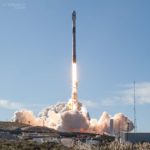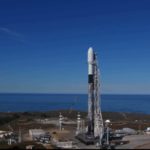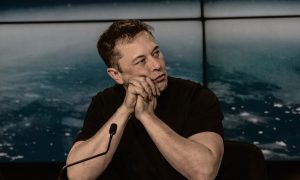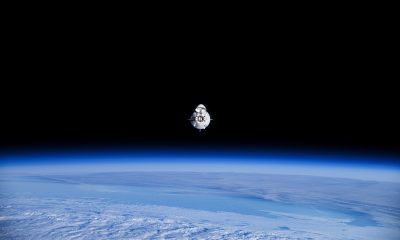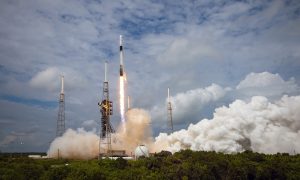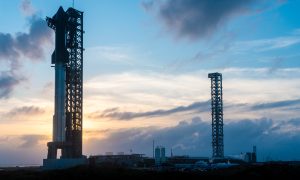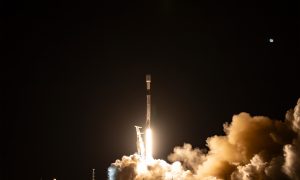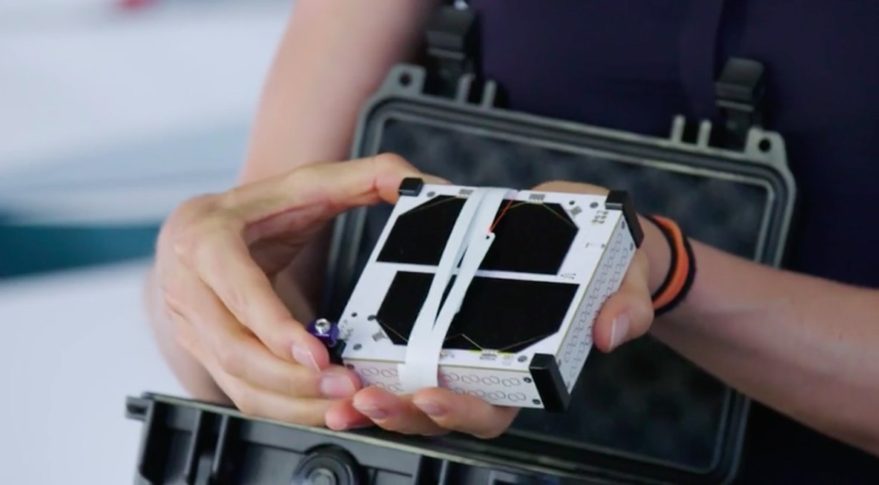

News
Startup fined $900k for launching illegal satellites, points to future space law challenges
Swarm Technologies, Inc., a satellite startup aiming to create the world’s lowest-cost satellite network, has been fined $900,000 by the U.S. Federal Communications Commission (FCC) for illegally launching and deploying four unauthorized satellites into orbit in January 2018 on a commercial Indian satellite launch vehicle. The satellites in question were Swarm’s SpaceBEE vehicles, which measure one quarter the size of a traditional CubeSat, a class of small satellites measuring 10 cm in height, width, and depth. In December 2017, the FCC deemed the SpaceBEE size too small for the U.S. Air Force’s traditional technology to track with routine methods and declined a license, but the satellites were placed into orbit regardless. With satellite and rocket launch startups proliferating as space access becomes more affordable, the debate over ensuring safety in this international arena is likely expand.
Swarm requested an experimental license from the FCC in April 2017, a first step for any satellite operator to ensure compliance with current international space laws, and their plan was to launch in September 2017, although that date was later delayed. Spaceflight Industries was next hired to connect Swarm with a launch provider and ensure its integration with the rest of the rocket’s payload. After the FCC declined the license in December 2017, Swarm applied for a new license in January 2018 for satellites meeting CubeSat specifications, but the original SpaceBEEs were already loaded onto the contracted Indian Polar Satellite Launch Vehicle (PSLV) and subsequently launched on January 12, 2018.
When news of the SpaceBEE deployment broke, concerns over regulatory backlash spread throughout the satellite community. The FCC issued an Enforcement Advisory on April 12, 2018 warning about consequences for communications companies failing to comply with licensing requirements, including a note to launch providers on how launch activities may be impacted if an unauthorized satellite payload needs to be removed. In a decision released December 20, 2018, Swarm Technologies was ordered to pay the fine and implement a five-year compliance plan.
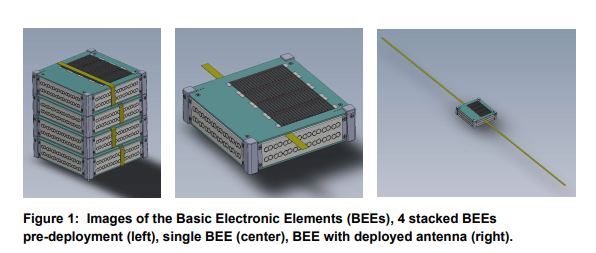
Since the very first satellite was successfully launched by the Soviet Union on October 4, 1957, activities in space have been largely conducted by national governments and companies affiliated with them. However, the new space era is quickly changing that environment, rapidly opening up the beyond-Earth domain to private citizens. Billionaires like Elon Musk of Tesla and SpaceX, Jeff Bezos of Amazon and Blue Origin, and Richard Branson of Virgin and Virgin Galactic have mostly been the face of private/commercial space industry in recent years, but the technologies they’ve developed are also ushering in a new wave of affordable access to space, and with it, new technologies that don’t fit the traditional mold of “old space”.
The legal foundation for current space laws is the 1967 Treaty on Principles Governing the Activities of States in the Exploration and Use of Outer Space, including the Moon and Other Celestial Bodies, i.e., the “Outer Space Treaty”. Under this Treaty and subsequent treaties and laws arising from it, states, or nations, rather, are responsible for any space activities conducted by their own nationals, meaning a regulatory process that must be enforced. Where access to space was once expensive and difficult, the significantly lowered threshold has brought in a field full of players ready to take their shot at participating in the coming space economy and maybe, as seen with Swarm Technologies, even take a few risks to get there.
While the illegal launch of Swarm’s satellites was caught rather quickly (first by the community of amateur space trackers) and action was taken to penalize it, what’s to stop nations in the future from lowering standards to attract private customers? As stated in the FCC’s Enforcement Advisory, “Satellites authorized by an administration other than the United States do not require any FCC approval if Earth station operations are exclusively outside the United States.” Pressure from the international community to comply with treaties will only work to the extent that 1) the penalties deter the profit potential from the industry; 2) the international community agrees the activity is actually unsafe; and 3) the resistance to reforming regulations to permit the activity in question is deemed justified. Innovation, especially out of Silicon Valley, has a history of breaking rules to bring about significant change; however, some would argue that space isn’t the place for that approach.
- The thrice-flown, Falcon 9 Block 5 rocket that put Swarm’s recent 3 satellites in orbit (all FCC approved): SpaceBEE-5, 6, and 7. | Credit: Pauline Acalin
The thrice-flown, Falcon 9 Block 5 rocket that put Swarm’s recent 3 satellites in orbit (all FCC approved): SpaceBEE-5, 6, and 7. | Credit: Pauline Acalin
The problem seems to be a simple matter of ethics: Don’t launch things into space that aren’t safe for Earth’s occupants. But according to the FCC, Swarm’s proposed satellites were merely “below the size threshold at which detection by the Space Surveillance Network (SSN) can be considered routine.” The licensing issue seemed to generally only be safety-related because of the satellites’ irregularity, not from the lack of actual tracking capability, something that is only going to increase as more players enter the new space arena.
Another point worth consideration is that Swarm’s SpaceBEE satellites are actually trackable using the same SSN network the FCC cited in its rejection of Swarm’s license request, and live tracking is ongoing via an independent tracking service called LeoLabs. According to Dr. Sara Spangelo, one of the co-founders of Swarm Technologies, the satellites are equipped with radar retro-reflector technology, something developed by a US-Navy research and development lab, which makes their radar signature as bright as a CubeSat. The FCC has also granted the company a temporary experimental authorization to test the previously-illegal satellites’ orbital and tracking data. Thus, the question for the future is not so much whether the safety concerns are valid, but whether preventative rules will be waived where newer technology can demonstrate their compliance outside traditional standards.
News
Tesla UK sales see 14% year-over-year rebound in June: SMMT data
The SMMT stated that Tesla sales grew 14% year-over-year to 7,719 units in June 2025.

Tesla’s sales in the United Kingdom rose in June, climbing 14% year-over-year to 7,719 units, as per data from the Society of Motor Manufacturers and Traders (SMMT). The spike in the company’s sales coincided with the first deliveries of the updated Model Y last month.
Model Y deliveries support Tesla’s UK recovery
Tesla’s June performance marked one of its strongest months in the UK so far this year, with new Model Y deliveries contributing significantly to the company’s momentum.
While the SMMT listed Tesla with 7,719 deliveries in June, independent data from New AutoMotive suggested that the electric vehicle maker registered 7,891 units during the month instead. However, year-to-date figures for Tesla remain 2% down compared to 2024, as per a report from Reuters.
While Tesla made a strong showing in June, rivals are also growing. Chinese automaker BYD saw UK sales rise nearly fourfold to 2,498 units, while Ford posted the highest EV growth among major automakers, with a more than fourfold increase in the first half of 2025.
Overall, the UK’s battery electric vehicle (BEV) demand surged 39% to to 47,354 units last month, helping push total new car sales in the UK to 191,316 units, up 6.7% from the same period in 2024.
EV adoption accelerates, but concerns linger
June marked the best month for UK car sales since 2019, though the SMMT cautioned that growth in the electric vehicle sector remains heavily dependent on discounting and support programs. Still, one in four new vehicle buyers in June chose a battery electric vehicle.
SMMT Chief Executive Mike Hawes noted that despite strong BEV demand, sales levels are still below regulatory targets. “Further growth in sales, and the sector will rely on increased and improved charging facilities to boost mainstream electric vehicle adoption,” Hawes stated.
Also taking effect this week was a new US-UK trade deal, which lowers tariffs on UK car exports to the United States from 27.5% to 10%. The agreement could benefit UK-based EV producers aiming to expand across the country.
News
Tesla Model 3 ranks as the safest new car in Europe for 2025, per Euro NCAP tests
Despite being on the market longer than many of its rivals, the Tesla Model 3 continues to set the bar for vehicle safety.

The Tesla Model 3 has been named the safest new car on sale in 2025, according to the latest results from the Euro NCAP. Among 20 newly tested vehicles, the Model 3 emerged at the top of the list, scoring an impressive 359 out of 400 possible points across all major safety categories.
Tesla Model 3’s safety systems
Despite being on the market longer than many of its rivals, the Tesla Model 3 continues to set the bar for vehicle safety. Under Euro NCAP’s stricter 2025 testing protocols, the electric sedan earned 90% for adult occupant protection, 93% for child occupant protection, 89% for pedestrian protection, and 87% for its Safety Assist systems.
The updated Model 3 received particular praise for its advanced driver assistance features, including Tesla’s autonomous emergency braking (AEB) system, which performed well across various test scenarios. Its Intelligent Speed Assistance and child presence detection system were cited as noteworthy features as well, as per a WhatCar report.
Other notable safety features include the Model 3’s pedestrian-friendly pop-up hood and robust crash protection for both front and side collisions. Euro NCAP also highlighted the Model 3’s ability to detect vulnerable road users during complex maneuvers, such as turning across oncoming traffic.
Euro NCAP’s Autopilot caution
While the Model 3’s safety scores were impressive across the board, Euro NCAP did raise concerns about driver expectations of Tesla’s Autopilot system. The organization warned that some owners may overestimate the system’s capabilities, potentially leading to misuse or inattention behind the wheel. Even so, the Model 3 remained the highest-scoring vehicle tested under Euro NCAP’s updated criteria this year.
The Euro NCAP’s concerns are also quite interesting because Tesla’s Full Self-Driving (FSD) Supervised, which is arguably the company’s most robust safety suite, is not allowed for public rollout in Europe yet. FSD Supervised would allow the Model 3 to navigate inner city streets with only minimal human supervision.
Other top scorers included the Volkswagen ID.7, Polestar 3, and Geely EX5, but none matched the Model 3’s total score or consistency across categories. A total of 14 out of 20 newly tested cars earned five stars, while several models, including the Kia EV3, MG ZS, and Renault 5, fell short of the top rating.
Elon Musk
Why Tesla’s Q3 could be one of its biggest quarters in history
Tesla could stand to benefit from the removal of the $7,500 EV tax credit at the end of Q3.

Tesla has gotten off to a slow start in 2025, as the first half of the year has not been one to remember from a delivery perspective.
However, Q3 could end up being one of the best the company has had in history, with the United States potentially being a major contributor to what might reverse a slow start to the year.
Earlier today, the United States’ House of Representatives officially passed President Trump’s “Big Beautiful Bill,” after it made its way through the Senate earlier this week. The bill will head to President Trump, as he looks to sign it before his July 4 deadline.
The Bill will effectively bring closure to the $7,500 EV tax credit, which will end on September 30, 2025. This means, over the next three months in the United States, those who are looking to buy an EV will have their last chance to take advantage of the credit. EVs will then be, for most people, $7,500 more expensive, in essence.
The tax credit is available to any single filer who makes under $150,000 per year, $225,000 a year to a head of household, and $300,000 to couples filing jointly.
Ending the tax credit was expected with the Trump administration, as his policies have leaned significantly toward reliance on fossil fuels, ending what he calls an “EV mandate.” He has used this phrase several times in disagreements with Tesla CEO Elon Musk.
Nevertheless, those who have been on the fence about buying a Tesla, or any EV, for that matter, will have some decisions to make in the next three months. While all companies will stand to benefit from this time crunch, Tesla could be the true winner because of its sheer volume.
If things are done correctly, meaning if Tesla can also offer incentives like 0% APR, special pricing on leasing or financing, or other advantages (like free Red, White, and Blue for a short period of time in celebration of Independence Day), it could see some real volume in sales this quarter.
You can now buy a Tesla in Red, White, and Blue for free until July 14 https://t.co/iAwhaRFOH0
— TESLARATI (@Teslarati) July 3, 2025
Tesla is just a shade under 721,000 deliveries for the year, so it’s on pace for roughly 1.4 million for 2025. This would be a decrease from the 1.8 million cars it delivered in each of the last two years. Traditionally, the second half of the year has produced Tesla’s strongest quarters. Its top three quarters in terms of deliveries are Q4 2024 with 495,570 vehicles, Q4 2023 with 484,507 vehicles, and Q3 2024 with 462,890 vehicles.
-

 Elon Musk4 days ago
Elon Musk4 days agoTesla investors will be shocked by Jim Cramer’s latest assessment
-

 News1 week ago
News1 week agoTesla Robotaxi’s biggest challenge seems to be this one thing
-

 Elon Musk2 weeks ago
Elon Musk2 weeks agoFirst Look at Tesla’s Robotaxi App: features, design, and more
-

 News2 weeks ago
News2 weeks agoSpaceX and Elon Musk share insights on Starship Ship 36’s RUD
-

 News2 weeks ago
News2 weeks agoWatch Tesla’s first driverless public Robotaxi rides in Texas
-

 News1 week ago
News1 week agoWatch the first true Tesla Robotaxi intervention by safety monitor
-

 News2 weeks ago
News2 weeks agoTesla has started rolling out initial round of Robotaxi invites
-

 Elon Musk2 weeks ago
Elon Musk2 weeks agoTesla to launch in India in July with vehicles already arriving: report


